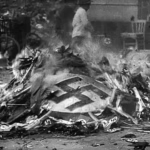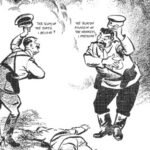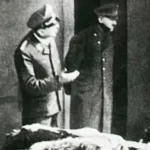By April 26, Berlin was nearly sealed. The Soviets had reached the heart of the city, and shellfire pounded the Reich Chancellery grounds without pause. That same day marked the final collapse of one of the Nazis’ last lifelines: Tempelhof Airport was rendered unusable by advancing Soviet forces. Though a few flights had still been possible the day before, April 26 marked the end. The airfield was under direct fire. Any pretense of escape by plane was now impossible.
And yet, one final, astonishing flight did make it through.
Hanna Reitsch, a renowned German test pilot and staunch Nazi loyalist, flew into Berlin under withering fire with General Robert Ritter von Greim, who had just been named the new head of the Luftwaffe after Göring’s dismissal. During the flight, von Greim was wounded in the leg by Soviet kground fire. Reitsch took control of the plane, landed it on the East-West Axis, using Berlin’s broad boulevards as an improvised runway. They then made their way to the Führerbunker, where Hitler greeted them personally and gave them their final assignments.
Hitler was not boarding a plane. He was welcoming visitors. This moment is essential because Reitsch and von Greim both later confirmed his presence in the bunker and their interactions with him during these final days.
And yet, despite this overwhelming documentation, the television show Hunting Hitler has promoted the baseless theory that Hitler escaped Berlin via a final flight out of Tempelhof on April 25. The argument goes something like this: if Hitler was sending planes filled with his personal effects, artwork, and prized possessions to his retreat near Berchtesgaden—why wouldn’t he have followed them?
But this is a textbook example of a logical fallacy. The act of sending property somewhere is not proof that the sender intends to go. In truth, Hitler sent many things south in April. But he had also made clear—again and again—that he would not leave Berlin. He saw himself as a martyr, destined to fall with the city.
And Hunting Hitler leaves out some rather inconvenient facts. One of Hitler’s aircraft filled with valuables was shot down en route, and the cargo—artwork, silverware, Nazi memorabilia—was later recovered and auctioned off. If the supposed escape plan was to flee discreetly, sending high-profile, cargo-laden planes into Allied-controlled airspace was not only impractical—it was suicidal.
More damning, however, is the presence of Hanna Reitsch in the bunker. If Hitler had flown out on the 25th, he would not have been there to personally receive Reitsch and von Greim on the 26th. Their testimony—especially Reitsch’s—is essential. She lived until 1979 and never once suggested that Hitler had escaped. On the contrary, she remained openly proud of her service, particularly in those final days. She never distanced herself from Hitler or denied what she witnessed. She believed in him to the end.
In her memoirs and interviews, Reitsch described the bunker as a place of strange calm. Hitler, though physically frail, remained lucid and focused on his self-assigned role as a leader dying with his capital. She reported that he was fully committed to his death and gave them explicit orders to leave Berlin again—orders they followed soon after.
The Hunting Hitler theory not only contradicts eyewitnesses like Reitsch, but it also relies on an absence of logic and an intentional omission of everything that occurred afterward—from Hitler’s marriage to Eva Braun, to dictating his personal will and political testimony, to the daily interactions with staff and visitors until his suicide on April 30.
If Hitler had left on April 25, none of it could have happened. And dozens of people—many of whom lived long after the war—would have had to lie, consistently and in detail, for no personal gain.
But they didn’t lie. The bunker held. The sky closed. And Hitler remained underground, until the bitter end.
FULL SERIES:
Yes, Hitler Really Did Commit Suicide, 80 Years Ago
Part 1: April 20, 1945 – Hitler’s Last Birthday
Part 2: April 21, 1945 – The Net Tightens
Part 3: April 22, 1945 – The Breaking Point
Part 4: April 23, 1945 – The Succession Panic
Part 5: April 24, 1945 – The Axis of Betrayal
Part 6: April 25, 1945 – No Way Out
Part 7: April 26, 1945 – The Sky Closes
Part 8: April 27, 1945 – Rienzi
Part 9: April 28, 1945 – Wedding Day
Part 10: April 29, 1945 – The Day Before the End













Leave a Reply